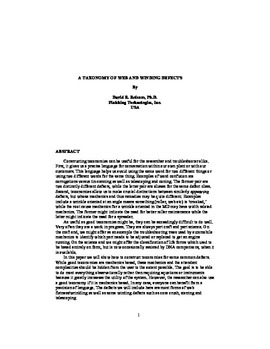| dc.contributor.author | Roisum, David R. | |
| dc.contributor.other | International Conference on Web Handling (2019) | |
| dc.date.accessioned | 2019-06-04T16:16:35Z | |
| dc.date.available | 2019-06-04T16:16:35Z | |
| dc.date.issued | 2019-06 | |
| dc.identifier | oksd_icwh_2019_roisum | |
| dc.identifier.citation | Roisum, D. R. (2019, June). Taxonomy of web and winding defects. Paper presented at the Fifteenth International Conference on Web Handling (IWEB), Stillwater, OK. | |
| dc.identifier.uri | https://hdl.handle.net/11244/320259 | |
| dc.description.abstract | Constructing taxonomies can be useful for the researcher and troubleshooter alike. First, it gives us a precise language for conversation within our own plant or with our customers. This language helps us avoid using the same word for two different things or using two different words for the same thing. Examples of word confusion are corrugations versus tin-canning as well as telescoping and coning. The former pair are two distinctly different defects, while the latter pair are aliases for the same defect class. Second, taxonomies allow us to make crucial distinctions between similarly appearing defects, but whose mechanics and thus remedies may be quite different. Examples include a wrinkle oriented at an angle means something (roller, web etc.) is 'crooked,' while the root cause mechanics for a wrinkle oriented in the MD may have width related mechanics. The former might indicate the need for better roller maintenance while the latter might indicate the need for a spreader. | |
| dc.description.abstract | As useful as good taxonomies might be, they can be exceedingly difficult to do well. Very often they are a work in progress. They are always part craft and part science. On the craft end, we might offer as an example the troubleshooting trees used by automobile mechanics to identify which part needs to be adjusted or replaced to get an engine running. On the science end we might offer the classification of life forms which used to be based entirely on form, but is now occasionally assisted by DNA comparisons, when it is available. | |
| dc.description.abstract | In this paper we will show how to construct taxonomies for some common defects. While good taxonomies are mechanics based, these mechanics and the attendant complexities should be hidden from the user to the extent possible. The goal is to be able to do most everything observationally rather than requiring equations or instruments because it greatly increases the utility of the system. However, the researcher can also use a good taxonomy if it is mechanics based. In any case, everyone can benefit from a precision of language. The defects we will include here are most forms of web flatness/wrinkling as well as some winding defects such as core crush, starring and telescoping. | |
| dc.format | application/pdf | |
| dc.language | en_US | |
| dc.publisher | Oklahoma State University | |
| dc.rights | In the Oklahoma State University Library's institutional repository this paper is made available through the open access principles and the terms of agreement/consent between the author(s) and the publisher. The permission policy on the use, reproduction or distribution of the article falls under fair use for educational, scholarship, and research purposes. Contact Digital Resources and Discovery Services at lib-dls@okstate.edu or 405-744-9161 for further information. | |
| dc.title | Taxonomy of web and winding defects | |
| osu.filename | oksd_icwh_2019_roisum.pdf | |
| dc.type.genre | Conference proceedings | |
| dc.type.material | Text | |
| dc.subject.keywords | taxonomy | |
| dc.subject.keywords | classification | |
| dc.subject.keywords | troubleshooting tree | |
| dc.subject.keywords | wrinkle | |
| dc.subject.keywords | wind | |
| dc.subject.keywords | defect | |
